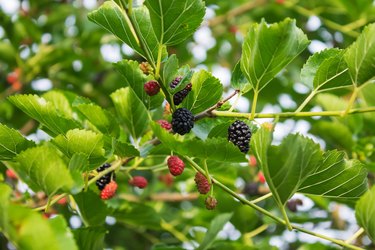
Mulberry trees (Morus spp.) are a species that are gender fluid—they may first be male, then female, then change back again. You can find individual mulberry trees that are dioecious—with only male flowers or only female flowers. But right next to such a tree might be a monoecious specimen, bearing both male or female flowers. And to add another veil of intrigue, sometimes mulberry flowers start out as one sex and transform halfway through the season.
What Gender Means in Mulberry Trees
Video of the Day
Being male or female is a full-time job for many species. In humans, for example, it can dictate the clothes you wear, the sports teams you can join and even your income potential. Male birds often have brighter plumage than their female counterparts, and male moose have racks while female moose do not.
Video of the Day
But when it comes to mulberry trees, the only part of the plant that has gender is the flowers. A mulberry tree is termed male if it bears male flowers that contain the pollen necessary to fertilize female flowers in order for them to produce fruit. A tree is termed female if all its flowers are female flowers, with stigma that receives pollen and a mechanism that directs the pollen to the ovary at its base. The terms "male tree" and "female tree" really don't apply to trees with both male and female flowers, or trees with flowers that can change from one sex to another.
That means that those mulberry trees with 100 percent male flowers are male, at least temporarily. And those mulberry trees bearing only female flowers are female. And a lot of mulberry trees are neither.
Flower Gender
Although the trees themselves may not be dependably male or female, every mulberry flower does have a gender that you can determine for a particular moment in time, even if that gender may change at some point in the future. Tiny mulberry blossoms grow in drooping clusters called catkins. Each of the three species of mulberry has flowers that present slightly differently. The flowers of black mulberry (Morus nigra) are small spiky catkins, green in color. Those of the red mulberry (Morus rubra) are pale green catkins, while those of white mulberry (Morus alba) are small green spikes.
However, the male flowers of each type of mulberry function similarly. A male mulberry flower has four reproductive organs called stamens that sit on stems called filaments. A female flower has one reproductive organ called a pistil that is placed on a threadlike style. The pistil has a stigma that receives pollen, which the style directs to the ovary at its base.
Can you detect these organs in such small flowers? Possibly, if you use a magnifying glass and inspect a flower very carefully. If you see a filament—a very slender stemlike growth—the flower is male. If there is no stemlike growth, the flower is female. It is easier, though, to determine sex by the length of the flower catkins. Male catkins can get to 2 inches long and are rather narrow, while female catkins top out at 1 inch and are wider.